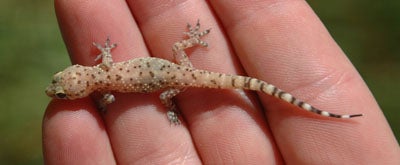SCIENTIFIC NAME:
Hemidactylus turcicus
STATUS:
Exotic.
DESCRIPTION:
A fairly small gecko, Hemidactylus turcicus reaches only four to five inches in length. They have large elliptical eyes, but no eyelids. Their open eyes are protected by a transparent scale called a “spectacle”. Their skin is translucent to pinkish white, with black spotting on the body and spots or striping on the tail. They have rows of keeled knobby tubercles (nodules) down the back and tail. Toes are unwebbed, clawed and free of extended pads.
The toes of the gecko tend to attract a lot of attention, as they adhere to a wide variety of surfaces, which allows them to climb smooth vertical surfaces with ease. Each footpad of the gecko has almost 500,000 fine stiff hairs called “setae” that allow it to cling to vertical surfaces. In addition, the gecko’s toes are extremely double jointed, allowing them to peel off their toes from the tips of their toes inward. This allows them to grip the surface from different angles increasing surface tension.
DISTRIBUTION:
Hemidactylus turcicus is one of the most successful species of geckos in the world. Originally native to southern Europe, it has been successfully introduced over much of the world, intentionally and unintentionally. In Alabama, populations have been found sporadically in the southern half of the state.
HABITAT:
Found locally in and near buildings of urban areas. In nature it would be found under palm leaves and in the crevices of tree bark and rocky outcroppings.
FEEDING HABITS:
They are a voracious feeder on moths and small roaches and are especially attracted to outside lights in search of insects. Geckos are nocturnal and may be seen feeding on insects near lights after dark.
LIFE HISTORY AND ECOLOGY:
The Mediterranean house gecko is the most conspicuous gecko in North America. It can be found from twilight to dawn darting along walls and ceilings to feed on insects attracted by lights. Highly territorial, the males will vigorously defend their favorite foraging areas. They have a distinct voice, similar to a bird chirping or a high pitched squeak, which is thought to be a territorial message.
Mating occurs from March to July. The female lays clutches of one to two eggs from April to August. The female is easily identified in spring and summer months by the white eggs that can be seen through the translucent skin of the abdomen.
Mediterranean geckos have very few natural predators. Birds would feed on them, but seldom have an opportunity to prey on geckos since they are strongly nocturnal and therefore only appear at night. Unlike many reptiles and amphibians, this species also appears to be hardy to pesticides and herbicides.
References:
Knopf, Alfred A. 1979. The Audubon Society Field Guide to North American Reptiles and Amphibians. Chanticleer Press, Inc. New York. 743 pp.
Mirarchi, Ralph E. 2004. Alabama Wildlife, Volume One. The University of Alabama Press, Alabama. 209 pp.
Wikipedia, the Free Encyclodpedia; http://en.wikipedia.org
Author:
Marisa Lee, Wildlife Biologist, Division of Wildlife and Freshwater Fisheries






